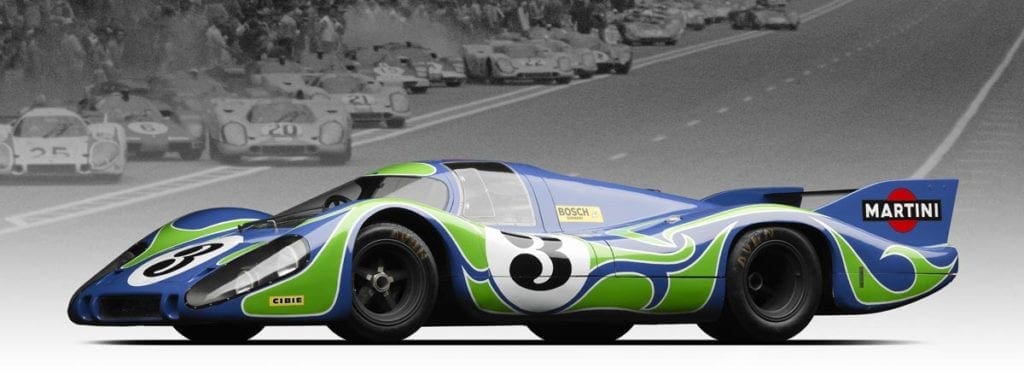Our long tail “Hippie Car” was purpose-built for Le Mans, where it reached nearly 240 mph en route to a 2nd place finish in 1970.
THESE CARS
Porsche started slowly in the evolution of their post-war racing production program. Racing versions of the initial 356 series, such as the 550, progress into the RS61, but they never really competed with the big boys in major races. Gradually, a series of cars increasing in speed and complexity evolved, from the 904 to the 910 and beyond. Then, dramatically, they introduced the 917 in the March 1969 Geneva Motor Show. This tubular chassis 4500cc, air-cooled 550-horsepower flat-12 engine, with striking aerodynamics was an immediate success. In a few weeks it had set top-speed record at 340 kph at Le Mans, and a track record at an average speed of 240 kph. The design of this engine followed the dictate of Automobile Club de l’Ouest (ACO) to reduce the average speeds achieved by the Ford MKIV and the Ferrari 330 P4. To accomplish this goal, they limited the prototypes to a maximum of 3,000 cc.
On hearing this, Porsche decided to re-design the 917
The reason stated for allowing “production” cars to displace up to 5,000 cc was because the ACO wanted to have other manufacturers taking part with their small-scale production models, particularly Ford and Lola. Thus, in March 1968 the regulators reduced the number of required production cars for homologation to 25. The design features in these cars were radical and different, an evolution from intense research at the racing department.
The highly efficient, horizontally opposed engine of up to 4,955
OUR CAR
This car, 917-043, has an exciting history. When it first appeared they painted it purple with random, psychedelic markings. After it qualified first, these markings were added to, with green and white edging all over the purple background. They chose Willi Kauhsen and Gérard Larrousse to drive the car in the 1970 Le Mans 24-hour. Gaining one position per hour they were third after seven hours. Bythe twentieth hour, they were second and maintained this position just behind 917K drivers Richard Attwood and Hans Herrmann in the winning 917-023. This race, held in the rain, was a dramatic event and one of the most famous competitions in Le Mans history.
I had a conversation with Willi Kauhsen at the Rennsport Reunion at Daytona in February 2008. Willi, ever s
When 917-043 came back to the factory for further research, The Porsche administration still believed that there were advantages to a perfectly balanced long-tail body, and studies were undertaken by race designer Norbert Singer, working with SERA, and finally, a 1971 version of the long-tail 917 was produced. A new body was put on this chassis as the result of this extensive study.
In April 1971, 917-043 came to the Le Mans Preliminary Test. This car, piloted by Jackie Oliver (winner of the 1969 24-hour Le Mans race in a Ford GT40) set a dramatic record with the fastest lap in the course’s history, 3 minutes 13.6 seconds, an average speed of over 250 kilometers per hour and a top speed of 386 kilometers per hour, which was over 40 kilometers per hour faster than the 917Ks. This was good enough for the pole. They set these records on April 18th, 1971 and were a tribute to the Porsche administration’s dedication to the long-tail, which has been maligned because of its dangerous handling characteristics. Under John Wyer’s control, 917-043 performed admirably but while leading the race for eleven hours it retired at 5:00 AM because of weak oil pressure.
917-043 returned to the factory and the body was reconverted into the 1970 long version, which they used in aerodynamic tests for several years. In 1975 they sold the chassis and body to Vasek Polak after being renumbered 917-044, an aberration the factory corrected and later properly authenticated as 917-043. We could trade this car for an unrestored S-series Mercedes Tourer and a Cunningham C-3 coupe, a swap I never regretted.
It was indeed exciting to have the car on the track at Daytona in 2008 for the Rennsport Reunion. It remains a popular item in the collection, as one of the most externally recognizable Porsches. The problem, from a collector’s point of view, is that the winners of the 70s and beyond are prototypes and these cars are essentially inoperable on the road, and therefore do not get to use, even on our three-acre museum track.

It was incredibly unstable, using all the road at speed.
Brian Redman











